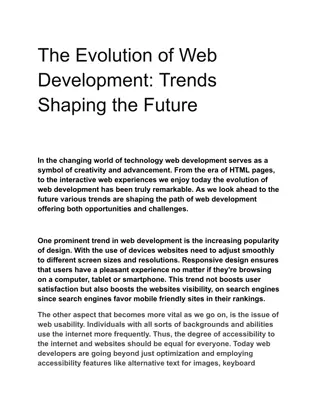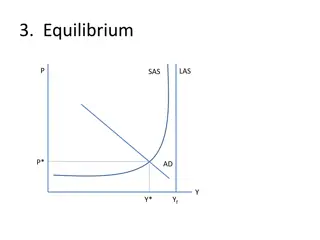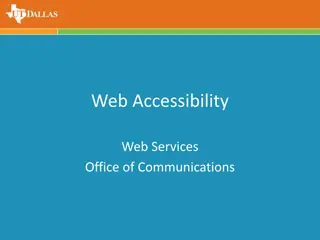Understanding the Crowding-out Effect in Philanthropy: Insights and Contingencies
The crowding-out effect in philanthropy explores how changes in government funding influence private donations and vice versa. Research suggests that a decrease in government support may not be fully compensated by private donors. Contingencies such as location and study methodologies impact the extent of crowding-out. The metaphor of a "waterbed effect" highlights the complex dynamic between government funding and philanthropy, prompting further empirical investigation.
Download Presentation

Please find below an Image/Link to download the presentation.
The content on the website is provided AS IS for your information and personal use only. It may not be sold, licensed, or shared on other websites without obtaining consent from the author. Download presentation by click this link. If you encounter any issues during the download, it is possible that the publisher has removed the file from their server.
E N D
Presentation Transcript
The Crowding-out Effect : Whatdoes the research tell us? Ren Bekkers VU University Amsterdam The Netherlands Jewish Funders Conference Tel Aviv March 17, 2015
The Crowding-out Effect Occurs when a decrease in government funding leads to an increase in philanthropic funding for a cause. Or vice versa, when an increase in philanthropy reduces government funding. March 17, 2015 Jewish Funders Conference, Tel Aviv 2
The Waterbed Effect Private donations Government grants Friedman (1962) called this the crowding-out effect. The metaphor assumes the water mass is constant & contained. In a JC interview, Hagai Katz (2010) said Israelis view philanthropy and government funding as a zero-sum game . March 17, 2015 Jewish Funders Conference, Tel Aviv 3
Questioning the metaphor The metaphor is not born out of research. For a researcher, it is a testable hypothesis. Empirical tests may as well reveal the reverse effect of crowding-in : when an increase in government funding increases philanthropic activity. The research question is: when and where occurs how much crowding-out? March 17, 2015 Jewish Funders Conference, Tel Aviv 4
A meta-analysis Crowding-out Crowding-in De Wit, A. & Bekkers, R. (2014). Government support and charitable donations: A meta-analysis of the crowding-out hypothesis. Paper presented at the 43dARNOVA Conference, Denver, November 20-22, 2014. March 17, 2015 Jewish Funders Conference, Tel Aviv 5
A severe cut in government funding to nonprofit organisations is not likely, on average, to be made up by donations from private donors. Abigail Payne (1998) Across all the published studies, a $1 increase in government support is associated with a $0.22 decrease in private charitable donations on average. March 17, 2015 Jewish Funders Conference, Tel Aviv 6
Contingencies US-based studies find more crowding-out than studies from elsewhere, including Europe. Experiments in controlled environments (mostly with students) find more crowding- out than studies analyzing archival data from nonprofit organizations. March 17, 2015 Jewish Funders Conference, Tel Aviv 7
The crowding-out effect varies Between Societies (macro-level) Organizations (meso-level) Citizens (micro-level) And it varies over time. March 17, 2015 Jewish Funders Conference, Tel Aviv 8
N = 111, r = .011 March 17, 2015 Jewish Funders Conference, Tel Aviv 9
March 17, 2015 Jewish Funders Conference, Tel Aviv 10
March 17, 2015 Jewish Funders Conference, Tel Aviv 11
Taxes and giving 90 Tax burden % of GDP 80 70 60 Proportion of population giving to charity 50 40 Philanthropy of GDP 30 20 10 Sources: Committed to Give, 2009-2011; Giving USA, 2014; Giving in the Netherlands 2015 0 United States Israel the Netherlands March 17, 2015 Jewish Funders Conference, Tel Aviv 12
EU investments in innovation In the European Foundations for Research and Innovation (EUFORI) Study, a consortium of 34 national experts documented ~12,000 foundations supporting R&I in Europe. In which countries are foundations most active? How do foundations view their relationship with government? March 17, 2015 Jewish Funders Conference, Tel Aviv 13
N = 28 r = - .176 March 17, 2015 Jewish Funders Conference, Tel Aviv 14
N = 28 r = 0.567 March 17, 2015 Jewish Funders Conference, Tel Aviv 15
Four models of collaboration Competitive: try to do better than government or make government do better Initiating: start a program, and export it into government policy Substituting: take over government tasks Complementary: work towards similar goals and strengthen each other as partners March 17, 2015 Jewish Funders Conference, Tel Aviv 16
Creating a Giving Culture Modesty: Do not let your left hand know what your right hand is doing (Matthew 6:3; Maimonides second degree) Philanthropy should not be a dirty word. Social entrepreneurship could be the first degree (help a person help himself). Education could play a role in creating a giving culture, e.g. through service learning. March 17, 2015 Jewish Funders Conference, Tel Aviv 17
When is that culture change scheduled? On Thursday the 17th, at 3.30 PM Text from a cartoon in Dutch by John Reid, Bastiaan Geleijnse and Jean-Marc van Tol, April 15, 2011 March 17, 2015 Jewish Funders Conference, Tel Aviv 18
March 17, 2015 Jewish Funders Conference, Tel Aviv 19
Popular concerns Coverage: the general level of service provision may suffer when the government retreats. Inequality: philanthropy may fund specific causes, but not others; Matthew-effects will help those causes with an early advantage. Too much influence on public policy for philanthropists leading to arbitrariness, nepotism and inequality. Lack of trust among population and between government and philanthropy sector. March 17, 2015 Jewish Funders Conference, Tel Aviv 20
What we need is A serious political discussion about the role of philanthropy in public policy. Decent research informing policy decisions, paying attention to undesirable side-effects. Thorough evaluation of the results of any changes that will be implemented. March 17, 2015 Jewish Funders Conference, Tel Aviv 21
Ingredients People are longing for a more caring society and are prepared to contribute. People enjoy giving and volunteering more than paying taxes. They dislike organizational inefficiency. People respond to tax incentives and changes in government subsidies, but not that much. March 17, 2015 Jewish Funders Conference, Tel Aviv 22
Flexibility is the rule The crowding-out effect is flexible, open to modification. Governments, nonprofit organizations, philanthropists and the public at large can influence it. March 17, 2015 Jewish Funders Conference, Tel Aviv 23
Conditions for cooperation Meeting Knowing Strengthening each other; mutual trust. Accountability and (some) regulation. Public confidence and transparancy. Self-organization of the sector; speaking with one voice. March 17, 2015 Jewish Funders Conference, Tel Aviv 24
Alternative visions Aiming for a substitution effect, the resulting crowd out will be far from perfect. If nonprofit organizations are viewed as partners in public policy, this would help. Think from a crowding in hypothesis, even if subsidies are not changing. Present subsidies as matching grants. March 17, 2015 Jewish Funders Conference, Tel Aviv 25
Framing the incentive as a match 35% +90% 30% +46% 25% 20% 15% 10% 5% 0% control group 50% rebate: price = 0,50 100% match: price = 0,50 Proportion of the reward for participation in GINPS04 donated by participants March 17, 2015 Jewish Funders Conference, Tel Aviv 26
Thanks, says Ren Bekkers Professor & Director Center for Philanthropic Studies VU University Amsterdam r.bekkers@vu.nl Twitter: @renebekkers Blog: renebekkers.wordpress.com March 17, 2015 Jewish Funders Conference, Tel Aviv 27
Local cross-sector collaborations Private foundations in the Netherlands with a local focus receive more funding requests from nonprofits. Interest increases in what works in cross- sector collaborations, also from the government. Community foundations are now being established. March 17, 2015 Jewish Funders Conference, Tel Aviv 28
Seed money: target $3,000 2000 1800 1600 1400 1200 1000 800 600 400 200 0 10% 33% 67% No refund Refund March 17, 2015 Jewish Funders Conference, Tel Aviv 29
60% 55% 55% 51% 48% 50% 44% 41% 40% 30% 20% 10% 0% Change in subsidies after increase in donations Change in donations after increase in subsidies Change in fundraising effort after increase in subsidies no increase increase Bron: CBF. 2005-2010 March 17, 2015 Jewish Funders Conference, Tel Aviv 30
HNW 2013 Survey 13% response rate from millionaires Average giving: 5,200 = 1.9% of income Heavily skewed: 80/20 rule Highest amounts donated by young self- employed entrepreneurs Increase from 2,300 in 2009 March 17, 2015 Jewish Funders Conference, Tel Aviv 31
If the government cuts, I will give more 4 19 agree (completely) 37 neutral 38 disagree (completely) 59 42 Dutch population HNW sample March 17, 2015 Jewish Funders Conference, Tel Aviv 32
Total giving per year by willingness to compensate government cuts 6,150 5,431 If the government cuts, I will give more 4,539 disagree (completely) neutral agree (completely) 452 246 155 Dutch population HNW sample March 17, 2015 Jewish Funders Conference, Tel Aviv 33























